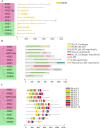Genome-wide identification of the NHE gene family in Coilia nasus and its response to salinity challenge and ammonia stress
- PMID: 35858854
- PMCID: PMC9297642
- DOI: 10.1186/s12864-022-08761-9
Genome-wide identification of the NHE gene family in Coilia nasus and its response to salinity challenge and ammonia stress
Abstract
Background: In aquatic environments, pH, salinity, and ammonia concentration are extremely important for aquatic animals. NHE is a two-way ion exchange carrier protein, which can transport Na+ into cells and exchange out H+, and also plays key roles in regulating intracellular pH, osmotic pressure, and ammonia concentration.
Results: In the present study, ten NHEs, the entire NHE gene family, were identified from Coilia nasus genome and systemically analyzed via phylogenetic, structural, and synteny analysis. Different expression patterns of C. nasus NHEs in multiple tissues indicated that expression profiles of NHE genes displayed tissue-specific. Expression patterns of C. nasus NHEs were related to ammonia excretion during multiple embryonic development stages. To explore the potential functions on salinity challenge and ammonia stress, expression levels of ten NHEs were detected in C. nasus gills under hypotonic stress, hypertonic stress, and ammonia stress. Expression levels of all NHEs were upregulated during hypotonic stress, while they were downregulated during hypertonic stress. NHE2 and NHE3 displayed higher expression levels in C. nasus larvae and juvenile gills under ammonia stress.
Conclusions: Our study revealed that NHE genes played distinct roles in embryonic development, salinity stress, and ammonia exposure. Syntenic analysis showed significant difference between stenohaline fish and euryhaline fishes. Our findings will provide insight into effects of C. nasus NHE gene family on ion transport and ammonia tolerance and be beneficial for healthy aquaculture of C. nasus.
Keywords: Chinese tapertail anchovy; Gene expression; High environmental ammonia (HEA); Hypertonic stress; Hypotonic stress; Na+-H+ exchangers.
© 2022. The Author(s).
Conflict of interest statement
The authors declare no conflicts of interest.
Figures







Similar articles
-
Genome-wide identification of the Na+/H+ exchanger gene family in Lateolabrax maculatus and its involvement in salinity regulation.Comp Biochem Physiol Part D Genomics Proteomics. 2019 Mar;29:286-298. doi: 10.1016/j.cbd.2019.01.001. Epub 2019 Jan 9. Comp Biochem Physiol Part D Genomics Proteomics. 2019. PMID: 30660028
-
Gills full-length transcriptomic analysis of osmoregulatory adaptive responses to salinity stress in Coilia nasus.Ecotoxicol Environ Saf. 2021 Dec 15;226:112848. doi: 10.1016/j.ecoenv.2021.112848. Epub 2021 Oct 4. Ecotoxicol Environ Saf. 2021. PMID: 34619476
-
Transcriptomic analysis reveals different responses to ammonia stress and subsequent recovery between Coilia nasus larvae and juveniles.Comp Biochem Physiol C Toxicol Pharmacol. 2020 Apr;230:108710. doi: 10.1016/j.cbpc.2020.108710. Epub 2020 Jan 17. Comp Biochem Physiol C Toxicol Pharmacol. 2020. PMID: 31958509
-
NHE(VNAT): an H+ V-ATPase electrically coupled to a Na+:nutrient amino acid transporter (NAT) forms an Na+/H+ exchanger (NHE).J Exp Biol. 2009 Feb;212(Pt 3):347-57. doi: 10.1242/jeb.026047. J Exp Biol. 2009. PMID: 19151209 Free PMC article. Review.
-
A new paradigm for ammonia excretion in aquatic animals: role of Rhesus (Rh) glycoproteins.J Exp Biol. 2009 Aug;212(Pt 15):2303-12. doi: 10.1242/jeb.023085. J Exp Biol. 2009. PMID: 19617422 Review.
References
-
- Liu Y, Wen H, Qi X, Zhang X, Zhang K, Fan H, et al. Genome-wided its involvement in salinity regulation identification of the Na+/H+ exchanger gene family in Lateolabrax maculatus and its involvement in salinity regulation. Comp Biochem Physiol - Part D Genomics Proteomics. 2018;2019:286–298. doi: 10.1016/j.cbd.2019.01.001. - DOI - PubMed
-
- Claiborne JB, Blackston CR, Choe KP, Dawson DC, Harris SP, Mackenzie LA, et al. A mechanism for branchial acid excretion in marine fish: identification of multiple Na+/H+ antiporter (NHE) isoforms in gills of two seawater teleosts. J Exp Biol. 1999;202(Pt 3):315–324. doi: 10.1242/jeb.202.3.315. - DOI - PubMed
MeSH terms
Substances
Grants and funding
- BK20191145/General Program of Natural Science Foundation of Jiangsu Province of China
- BK20191145/General Program of Natural Science Foundation of Jiangsu Province of China
- BK20191145/General Program of Natural Science Foundation of Jiangsu Province of China
- BK20191145/General Program of Natural Science Foundation of Jiangsu Province of China
- BE2019361/the Key Research and Development (Modern Agriculture) Project of Jiangsu Province
LinkOut - more resources
Full Text Sources

